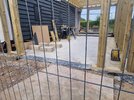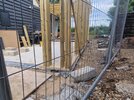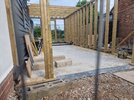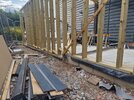Hello all,
My mum is having a timber framed extension built on to her house (side extension).
The extension has a utility room at the back and garage at the front.
The damp course around the utility matches the house as you would expect.
However, the garage wall drops down 150mm where the damp course is barely 10mm above ground.
The builders said a garage floor has to be 150mm lower than the house which turns out to be correct (some fire regulation).
While the floor has to be lower I don't see why the wall should be lower. In my view it should match the height of the extension with only the floor dropping.
The builders have accepted that the damp course is low and said they would put in drains.
-----
I would love to hear your opinion on this. My view is either 2 things should happen:
1. Pause construction and have the plains changed to a habitable room instead of a garage (my mum does not intend to use the garage as a garage, only storage).
2. The walls of the garage should match the wall of the utility so damp course follows through. This will not effect the concrete floor which will remain 150mm lower as the utility will be insulated and screeded.
I have attached some photos and would love to hear your opinions.
Many thanks.
My mum is having a timber framed extension built on to her house (side extension).
The extension has a utility room at the back and garage at the front.
The damp course around the utility matches the house as you would expect.
However, the garage wall drops down 150mm where the damp course is barely 10mm above ground.
The builders said a garage floor has to be 150mm lower than the house which turns out to be correct (some fire regulation).
While the floor has to be lower I don't see why the wall should be lower. In my view it should match the height of the extension with only the floor dropping.
The builders have accepted that the damp course is low and said they would put in drains.
-----
I would love to hear your opinion on this. My view is either 2 things should happen:
1. Pause construction and have the plains changed to a habitable room instead of a garage (my mum does not intend to use the garage as a garage, only storage).
2. The walls of the garage should match the wall of the utility so damp course follows through. This will not effect the concrete floor which will remain 150mm lower as the utility will be insulated and screeded.
I have attached some photos and would love to hear your opinions.
Many thanks.








